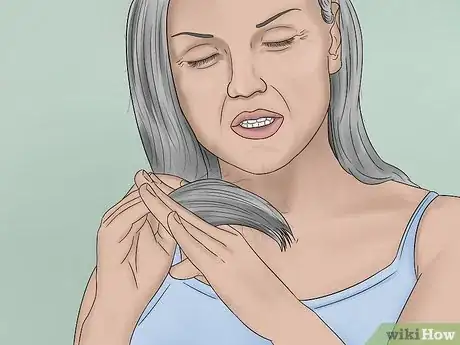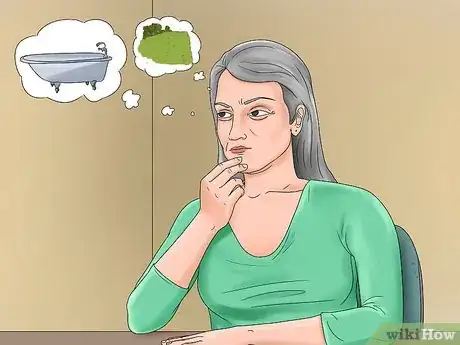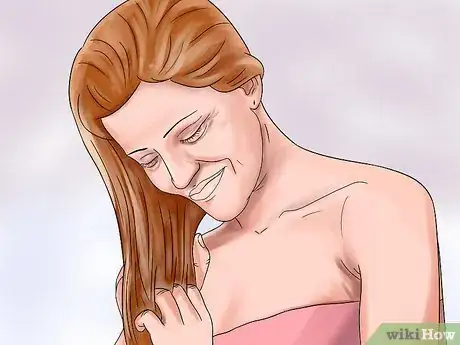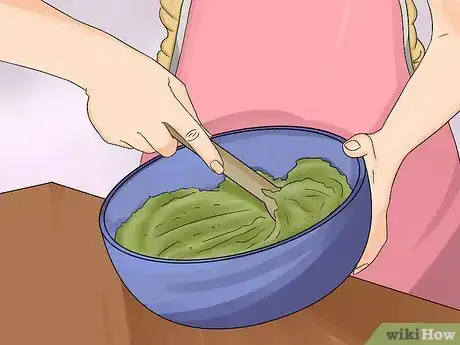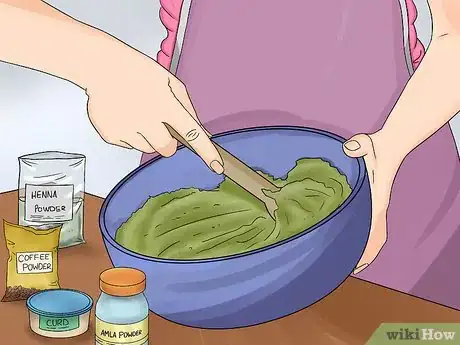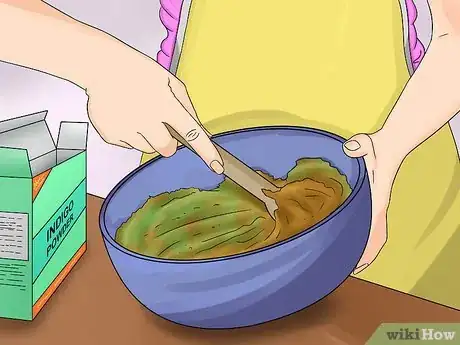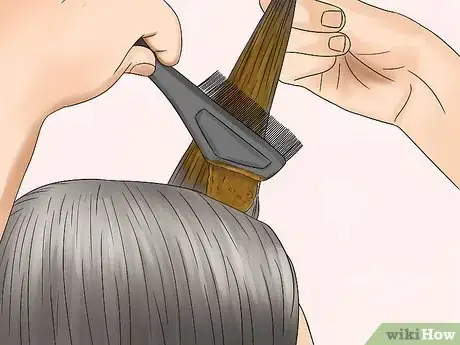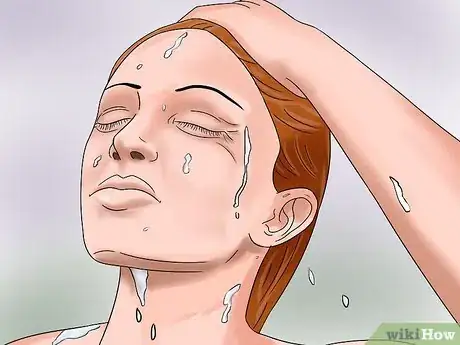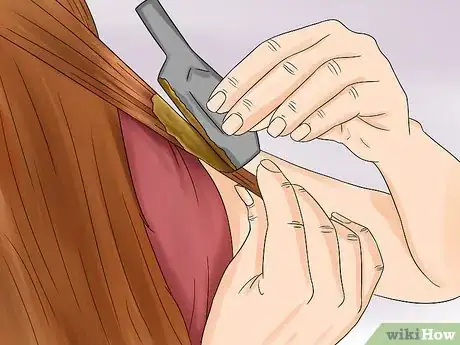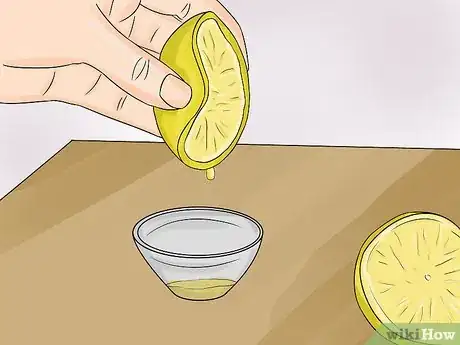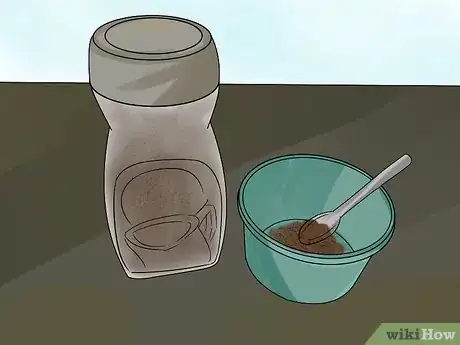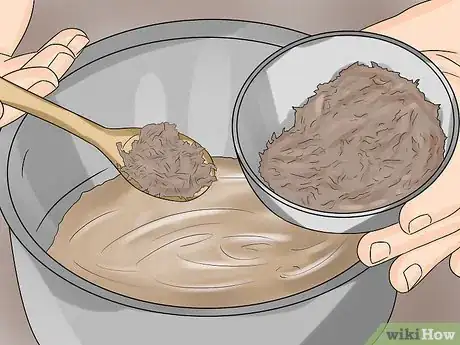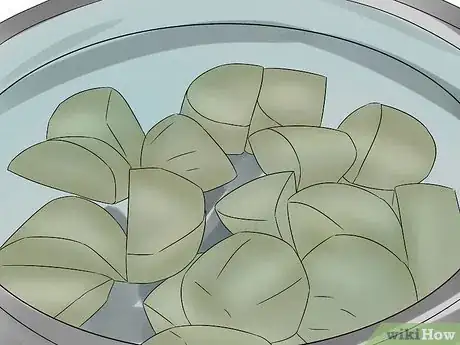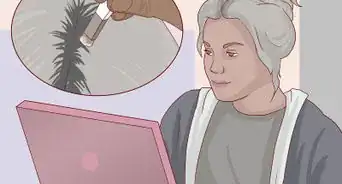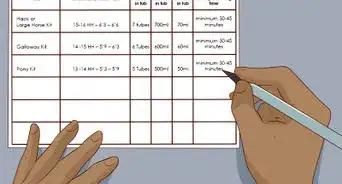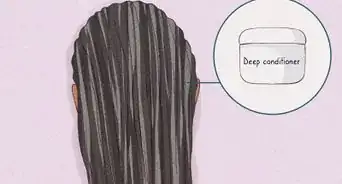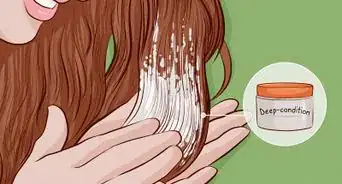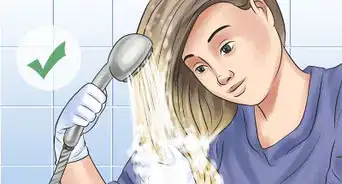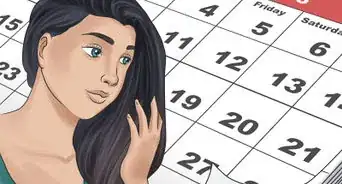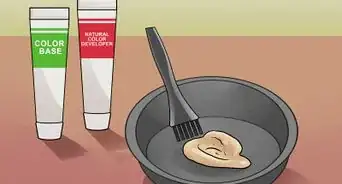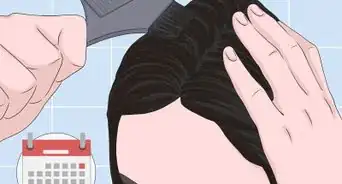This article was co-authored by Laura Martin. Laura Martin is a Licensed Cosmetologist in Georgia. She has been a hair stylist since 2007 and a cosmetology teacher since 2013.
There are 15 references cited in this article, which can be found at the bottom of the page.
This article has been viewed 301,583 times.
Dyeing your hair naturally takes more effort than using conventional hair dye. However, you can leave natural products on your hair longer than chemicals, so that you can get the color you desire. Cassia obovata, henna, and indigo are herbs you can use as dyes to cover gray hair. Henna colors hair with rich shades of red, brown and copper, and gold highlights. If you don't want such bright hues, you can blend henna with other herbs such as indigo that will tone down the colors.[1] With indigo, you can achieve cooler shades from medium brown to black. Covering gray hair with black takes the longest, since you will do the henna process first and then apply the indigo paste. Coloring made purely from herbs is nontoxic and less damaging than harsh chemical dyes. You can use rinses – such as those with coffee, tea, lemon, or potato peels – to darken, lighten or tint gray hair.[2]
Steps
Experimenting with Natural Colorants
-
1Decide if natural colorants are right for you. Naturally coloring your hair can be a messy process and take longer to process than chemical dyes. However, if your hair is damaged or easily damaged, natural colorants will be easier on your tresses than conventional hair dyes. It's up to you personally whether the benefits outweigh any inconvenience.[3]
- If you have sensitive skin, herbal colorants may be the best choice for you, since chemical hair dyes can cause contact dermatitis.[4]
- Natural colorants such as cassia obovata, henna and indigo are mixed into a paste that needs to sit out overnight. They also take longer to develop (from an hour to six hours) once applied to your hair.
- Keep in mind that the results you get with natural dyes can vary. If you have a specific desired look in mind, they might not be a good option for you.
-
2Manage your expectations. While you can plan for a general shade, natural colorants react differently to each individual's type and condition of hair. Your results will be unique and may be lighter, darker, or more varied in hue than you expect.
- Natural colorants, particularly tinting rinses, may not give you complete coverage of gray hair. How well it works for you depends on the method you use, how long you let it sit, and your hair type. You may need to repeat the process of coloring after 48 hours if your gray hair has not been covered successfully.
Advertisement -
3Do a strand test. Your individual hair type as well as various hair products you've used in the past affect how your hair takes to natural colorants. Save a few trimmings of hair the next time you get your hair cut, or snip a lock of hair near the back of your neck. Apply the colorant you want to use to the strand using the instructions for the method you've chosen.[5]
- After applying the colorant, wait the entire process time. Then, rinse the lock completely and allow it to dry in direct sunlight, if you can.
- Check the final results under bright natural lighting. If necessary, adjust the ingredient or processing time for your own hair – more or less, depending on the shade you desire.
- Keep in mind that your strand test may not provide an accurate result for all of your hair. Some parts of your hair, such as the top portion, may take the dye differently. This is because typical styling, touching, and environmental exposure can affect your hair.
-
4Decide where you will color your hair. Because natural hair colorants are typically messier than conventional hair dye, you will want to think about the best place to color your hair beforehand. Cassia obovata is not staining unless there is something added to it, like rhubarb. Henna and indigo, however, are both difficult to apply and very staining. [6]
- If the weather is nice, you may want to bring one to two large mirrors and dye your hair outside.
- If you're dyeing your hair in the bathroom, you may want to do so inside of a bathtub or shower.
- When you dye your hair, wear old clothes or a hairdresser's cape. Then, cover all surfaces with plastic sheeting or old towels.
- You can also get a friend to help you, which can minimize the mess.
-
5Use a natural conditioning treatment after coloring gray hair. When hair turns gray, not only the pigment changes. The cuticles are also thinned, making the strands of hair coarser and more prone to breakage.[7] You can restore moisture to your hair with a natural product: egg, honey and olive oil, or coconut oil.
- Cassia obovata, henna, lemon and tea can be drying to your hair, so especially consider doing a natural conditioning treatment afterwards.
- Mix a whole egg and apply it to clean, damp hair once a month. Leave the mixture in for twenty minutes, then rinse it out with cool water.[8]
- Massage 1/2 cup of honey and one to two tablespoons of olive oil into damp, clean hair. Allow the mixture to sit in your hair for twenty minutes, then rinse it out with warm water.[9]
- Coconut oil is in a solid state at room temperature, so warm it in your hands or a microwave (if the latter, make sure it is warm and not too hot before applying). Work a couple of teaspoons of it into damp hair and wrap your hair in an old towel (coconut oil can stain fabric). Let it sit for one to two hours, then fully rinse it out and shampoo your hair.[10]
Using Henna
-
1Consider cassia obovata to get blonde to strawberry blonde hair. For a blonde shade, use cassia powder with water or citrus juice. For strawberry blonde, add henna. Use pure cassia powder for blonde, or 80% cassia powder and 20% henna powder for strawberry blonde. Use water to transform the powder into a paste, or if you want an extra lightening effect, orange or lemon juice. Add liquid to the powder a little at a time until its consistency is similar to yogurt. Put the mixture in the refrigerator and let it sit for twelve hours.
- Use cassia obovata for blonde or gray hair. If you have gray hairs but the rest of your hair is darker than blonde, cassia obovata alone will only brighten and condition your darker hair, not lighten it to blonde.
- Use one box (100 grams) of cassia powder for short hair.
- Use two to three boxes (200-300 grams) of cassia powder for shoulder-length hair.
- Use four to five boxes (400-500 grams) of cassia powder for long hair.
-
2Prepare henna paste for red, brown or black hair. Mix into henna powder three teaspoons of amla powder, one teaspoon of coffee powder, and a little bit of curd or plain yogurt. Stir the ingredients well.[11] Slowly add one to two cups of hot water (not boiling) to the henna paste in a bowl until the paste is thick, not runny. Mix the contents. Close the bowl with a lid or tight plastic wrap. Let it sit for twelve hours to twenty-four hours, unrefrigerated before using it on your hair.
- Amla (Indian gooseberry) is nondrying and adds coolness to the red so that it is not quite so bright. You can omit the amla if you want a very vibrant orange-red. Amla volumizes hair as well as enhances texture and curls.
- Use 100 grams of henna powder for hair up to medium length, or 200 grams of henna for long hair.
- Henna can be drying, so you may want to add a conditioner to the paste the next morning, such as two to three tablespoons of olive oil and 1/5 cup moisturizing conditioner.
-
3Add indigo powder to the paste for brown hair. Once henna paste has sat for twelve to twenty-four hours, mix in indigo powder well. If the paste is not the consistency of thick yogurt, add warm water little by little until you achieve the right texture. Let the paste sit for fifteen minutes.
- If you have short hair, use one box (100 grams) of indigo.
- If you have shoulder-length hair, use two to three boxes (200-300 grams) of indigo.
- If you have long hair, use four to five boxes (400 to 500 grams) of indigo.
-
4Apply the paste to your hair. Put gloves on. Section your hair and apply the paste to damp or dry hair with your gloved hands, a pastry brush, or a coloring brush from a beauty supply store. Make sure that you cover all of your hair to the roots. You may find it handy to clip sections of hair back once you've finished coating them.
- Henna paste is thick, so don't try to rake it through your hair.
- Apply the paste to the roots of your hair first, since that is typically where the most hue and processing time is needed.[12]
-
5Cover your hair and let the paste soak in. If you have long hair, you may want to pull it up first into a clip. Use plastic wrap or a shower cap to protect the dye.
- For red hair, leave the paste on for about four hours.
- For brown or black hair, leave the paste in your hair for one to six hours.
- You can check the color by scraping off a little bit of the henna to see the result. When you've reached your desired color, you can rinse off the henna.
-
6Rinse out the paste thoroughly. Wear gloves when you're rinsing out the dye, or it will stain your hands.[13] Use a mild shampoo to wash your hair.[14] You can use moisturizing conditioner afterwards if desired.
- For red hair, you can dry and style as usual. For black hair, you'll follow this with indigo dye.
-
7Follow with indigo paste to get black hair. Add warm water to indigo powder little by little until you achieve a yogurt-like consistency. Mix in one teaspoon of salt per 100 grams of indigo powder. Let the paste sit for fifteen minutes. Apply the paste to damp or dry hair. Wear gloves. Put the paste on in sections, starting at the back of your head and moving forward. Coat the hair thoroughly to the roots.
- For short hair, use one box (100 grams) of indigo. For shoulder-length hair, use two to three boxes (200-300 grams) of indigo. For long hair, use four to five boxes (400 to 500 grams) of indigo.
- Once your hair is saturated with the paste, use a clip or hair pin to put your hair up. Wrap plastic wrap or a shower cap over your head. Let the paste sit in your hair for one to two hours.
- After one to two hours of processing time, rinse the paste completely out. You can use conditioner if desired. Dry and style your hair as usual.
Tinting Your Hair
-
1Use lemon juice as a natural lightener. You'll need access to sunshine for 30 minutes each session, for four to five sessions. Squeeze one to two lemons (depending on how long your hair is). Apply the juice to your hair with a brush.
- Optionally, you can add two parts coconut oil to one part lemon juice, to condition as you lighten.[15]
-
2Darken your hair with a coffee rinse. Put your head back into a bowl of strongly brewed, dark coffee. Squeeze the liquid out and then pour coffee through your hair a cup at a time. For more dramatic results, prepare a paste of instant coffee and hot water in a thick consistency, and paint it onto your hair in sections.[16]
- Clip up your hair and wrap it in a plastic bag for 30 minutes. Rinse it out under water and then dry your hair as normal.
-
3
-
4Try a potato peel rinse. You can darken gray hair with a rinse using one cup of potato skins. Mix in two cups of water. Bring the mixture to a boil in a lidded pot. Then simmer for five minutes. Remove the pot from the heat and let the mixture cool.[18]
- Strain out the potatoes. Use the water as a final rinse. You may want to pour it into an empty shampoo bottle to make application easier. Towel dry your hair and leave the rinse in.
Expert Q&A
Did you know you can get expert answers for this article?
Unlock expert answers by supporting wikiHow
-
QuestionHow can I get rid of grey hair naturally?
 Laura MartinLaura Martin is a Licensed Cosmetologist in Georgia. She has been a hair stylist since 2007 and a cosmetology teacher since 2013.
Laura MartinLaura Martin is a Licensed Cosmetologist in Georgia. She has been a hair stylist since 2007 and a cosmetology teacher since 2013.
Professional Hair Stylist
-
QuestionCan grey hair be turned black naturally?
 Laura MartinLaura Martin is a Licensed Cosmetologist in Georgia. She has been a hair stylist since 2007 and a cosmetology teacher since 2013.
Laura MartinLaura Martin is a Licensed Cosmetologist in Georgia. She has been a hair stylist since 2007 and a cosmetology teacher since 2013.
Professional Hair Stylist
-
QuestionHow can I color my grey hair naturally?
 Laura MartinLaura Martin is a Licensed Cosmetologist in Georgia. She has been a hair stylist since 2007 and a cosmetology teacher since 2013.
Laura MartinLaura Martin is a Licensed Cosmetologist in Georgia. She has been a hair stylist since 2007 and a cosmetology teacher since 2013.
Professional Hair Stylist
Warnings
- Don't leave dye paste sitting out unattended in reach of pets or children. You may want to clearly mark any dye in a container that requires refrigeration, so that no one mistakes it for food.⧼thumbs_response⧽
- Henna does not produce an even color. Instead, it introduces a variety of shades to your hair. It is more difficult to apply coverage-wise than conventional hair dye.⧼thumbs_response⧽
- Be careful not to get colorant into your eyes.⧼thumbs_response⧽
- If you use a pastry brush to apply colorant, make sure that you designate the brush only for that purpose, or else dispose of it once finished. You don't want to reuse the same brush for food preparation.⧼thumbs_response⧽
- If you are rinsing natural dyes out of your hair over a sink drain, consider using a drain catcher to avoid getting chunks of the substances in your plumbing.⧼thumbs_response⧽
- Henna is quite permanent, so you should be certain before committing to this look.[21]⧼thumbs_response⧽
- You may have difficulty finding a salon willing to work with henna-treated hair if you decide to go back to using chemical dyes later on.[22]⧼thumbs_response⧽
- Henna may loosen or relax curls.⧼thumbs_response⧽
References
- ↑ https://books.google.com/books?id=45qfCgAAQBAJ&lpg=PP1&pg=PA11#v=onepage&q&f=false
- ↑ https://books.google.com/books?id=45qfCgAAQBAJ&lpg=PP1&pg=PA11#v=onepage&q&f=false
- ↑ http://www.motherearthnews.com/natural-health/hair-color-natural-dyes
- ↑ https://www.ncbi.nlm.nih.gov/pubmed/27633650
- ↑ http://www.motherearthnews.com/natural-health/hair-color-natural-dyes
- ↑ http://www.hennaforhair.com/faq/cassiaobovata.html
- ↑ http://timesofindia.indiatimes.com/life-style/beauty/How-to-cover-that-grey-hair-naturally/articleshow/24691909.cms
- ↑ http://www.womansday.com/style/beauty/advice/g2276/homemade-hair-treatments/?slide=1
- ↑ http://www.womansday.com/style/beauty/advice/g2276/homemade-hair-treatments/?slide=5
- ↑ http://www.mindbodygreen.com/0-7612/why-you-should-put-down-that-conditioner-and-use-coconut-oil-instead.html
- ↑ http://timesofindia.indiatimes.com/life-style/beauty/How-to-cover-that-grey-hair-naturally/articleshow/24691909.cms
- ↑ http://www.goodhousekeeping.com/beauty/hair/g2754/haircolor-hacks-at-home/?slide=9
- ↑ http://offbeathome.com/dying-your-hair-red-with-henna/
- ↑ http://timesofindia.indiatimes.com/life-style/beauty/How-to-cover-that-grey-hair-naturally/articleshow/24691909.cms
- ↑ http://timesofindia.indiatimes.com/life-style/beauty/How-to-cover-that-grey-hair-naturally/articleshow/24691909.cms
- ↑ https://www.almanac.com/coffee
- ↑ https://www.youtube.com/watch?v=Q5HMHiy0XOU&feature=youtu.be&t=4
- ↑ https://www.youtube.com/watch?v=9-v-0JxLDtI&feature=youtu.be&t=46
- ↑ https://books.google.com/books?id=45qfCgAAQBAJ&lpg=PP1&pg=PA11#v=onepage&q&f=false
- ↑ http://www.goodhousekeeping.com/beauty/hair/g2754/haircolor-hacks-at-home/?slide=11
- ↑ http://offbeathome.com/dying-your-hair-red-with-henna/
- ↑ http://detoxinista.com/2012/08/6-things-you-should-know-before-using-henna-hair-dye/
About This Article
To cover gray hair naturally, apply a paste of cassia powder with water or citrus juice to your hair for a blonde shade. Alternatively, for a red, brown, or black color, try henna powder mixed with amla powder, coffee powder, and curd or plain yogurt. If you’d prefer to tint your hair, apply the juice of 1-2 lemons to your hair with a brush, and sit out in the sun for 30 minutes for a natural lightening effect. You can also lighten your hair with tea, such as chamomile. For a darkening effect, dip your hair into strongly brewed coffee. For more tips from our Beauty reviewer, including how to use a potato peel rinse, keep reading!

